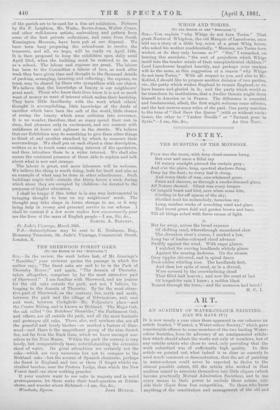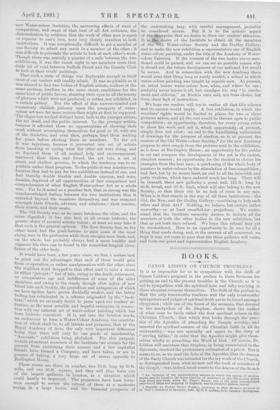ART.
AN ACADEMY OF WATER-COLOUR PAINTING.
(CAN WE HAVE IT?)
IT is now nearly a year since there appeared in our columns an article headed, " Wauted, a Water-colour Society," which gave considerable offence to some members of the two loading Water- colour Societies, from its advocacy of an amalgamated exhibi- tion which should admit the works not only of members, but of any outside artists who chose to send, only providing that the work submitted was of sufficiently high quality. In this article we pointed out, what indeed. is so clear as scarcely to need much comment or demonstration, that the art of painting in water-colours could never be expected to thrive to the utmost possible extent, till the artists who worked in that medium ceased to associate themselves into little cliques (which become practically Mutual Admiration Societies), and to use every means in their power to exclude those artists out- side their clique from free competition. To those who know anything of the constitution and management of the old and
mew Water-colour Societies, the narrowing effects of want of 'competition, and want of that best of all Art criticism, the 'demonstration by evidence that the work of other men is equal or superior to one's own, were very clearly manifest in both institutions. It was exceptionally difficult to get a member of one Society to admit any merit in a member of the other ; it 'was difficult to persuade the artists to look at each other's work. Though there was scarcely a quarter of a mile between the two 'exhibitions, it was the rarest sight to see members cross that little bit of road between Suffolk Street and the Guards' Club to look at their rivals' paintings.
That such a state of things was deplorable enough in itself most of our readers will readily admit. It was as pitiable as it 'was absurd to find two bodies of English artists, workers in the :same medium, dwellers in the same street, candidates for the same kind of public favour, shutting their eyes to all the beauty of pictures which were not produced, or rather, not exhibited, in a certain gallery. But the effect of this narrow-minded and 'excessively childish jealousy upon the prospects of water- colour art were far more serious than might at first be supposed. 'The clique-ism worked distinct harm, both to the younger artists, the art itself, and the public interest. To the younger artists, 'because it afforded them no opportunities of showing their -work without associating themselves, for good or ill, with one of the Societies, and even then, perhaps, kept them waiting for years before electing them as members. To the art at was injurious, because it prevented one set of artists .'from knowing or caring what the other set were doing, and .so deprived them of all mutual help and encouragement, aLarrowed their ideas, and forced the art into a set of strait and shallow grooves, in which the tendency was to re- petition rather than progress. To the public it was mischievous, .because they had to pay for two exhibitions instead of one, and had thereby double trouble and double expense, and were, besides, deprived of all opportunities of fair comparison and 'comprehension of what English Water-colour Art as a whole was. For be it noted as a peculiar fact, that so strong was the -unacknowledged feeling between the two institutions that it -extended beyond the members themselves, and was rampant amongst their friends, advisers, and relations,—their cousins, their sisters, and their aunts.
The Old Society was, as its name betokens, the older, and the 'more dignified ; it has also had, at all events hitherto, the greater share of assured artistic talent ; at least we may take it that such is the general opinion. The New Society has, on the -other band, had the good-fortune to gain some of the most .rising men in the profession while their energies were fresh, and, cti the whole, has probably always had a more healthy and vigorous life than can be found in the somewhat languid circu- ilation of the older body.
It would have been, a few years since, we fear, a useless task to point out the advantages that each of these would gain from co-operation, or rather, amalgamation with the other, since :the slightest word dropped to that effect used to raise a storm -in either ".tea-pot ;" but of late, owing to the death, retirement, an- comparative ago and indifference of some of the older members, and owing to the steady though slow influx of new 'blood into each Society, the prejudices and antagonism of which we have spoken have grown decidedly weaker, and the better 'feeling has culminated in a scheme, originated by the " Insti- lute," which we earnestly desire to press upon our readers' at- tention, as the most sensible and hopeful enterprise in connec- tion with our national art of water-colour painting which has "been hitherto conceived. It is, put into the briefest words, -an endeavour to form a Water-Colour Academy, the constitu- tion of which shall be, to all intents and purposes, that of the 'oyal Academy of Arts, the only very important difference 'being that there will only be one grade of membership, -"Associate" exhibitors being abolished. For this purpose, certain prominent members of the Institute (we abstain for the present from publishing their names) and a few capitalist friends have formed a Company, and have taken, or are in process df taking, a very large set of rooms opposite to Burlington House.
These rooms are three in number, two 75 ft. long by 35 ft. wille, null one 41.4t. square, and they will thus form one of the largest galleries in London, in a situation which could hardly be improved. The projectors have been fortu- nate .enough to secure the refusal of these at a moderate. natal, in a large house, and the financial prospects of the undertaking may, with careful management, probably be considered secure. But it is to the artistic aspect of thastlisterprise that we desire to draw our readers' attention. It is 4&,. ,desire of the Institute to obtain all the members of the 11111d Water-colour Society and the Dudley Gallery, and to make the new exhibition a representative one of English water-colour painting, under the title of the Academy of Water- colour Painting. If the consent of the two bodies above men- tioned could be gained, and we can see no possible reason why it should not, the future development of our national Art would be secure. And in connection with the new Academy there would arise that thing long so sorely needed, a school iu which water-colour painting was taught by capable men. At present, an artist learns water-colour how, when, and where he can; probably never learns it all, but smudges his way "to emolu- ment and oblivion," as Ruskin once said, not from choice, but from sheer lack of instruction.
We hope our readers will try to realise all that this scheme and its success would imply. A free exhibition, in which the members' rights would be limited to places for two or three pictures apiece, and all the rest would be thrown open to public competition; an opportunity, therefore, for every young artist to show his work and sell it, which opportunity, at present, simply does not exist ; an end to the humiliating submission of drawings for the purpose of election, as is at present the custom of the Old Water-colour Society,* for the new Academy propose to elect simply from the pictures sent to the exhibition, as is done at Burlington House ; an opportunity for the public to see and compare the development of the art in the easiest, simplest manner ; an opportunity for the student to choose his examples from the best men; a quickening of the whole body of painters in water-colours by the stimulation of free competition L and last, but by no means least, an end to all the miserable and petty rivalries, which have endured much too long. There will be beneath these new galleries a great hall, 125 ft. long by 45 ft. broad, and 30 ft. high, which will also belong to the new Society, so that there can be no lack of room in any case. What is it that stands in the way of all three institutions—the Old, the New, and the Dudley Gallery—combining to help each other and their Art ? Nothing, we believe, but certain rather unworthy—or at least uncalled-for—prejudices. We under- stand that the Institute earnestly desires to include all the members of both the other bodies in the new exhibition, but that as yet both have refused. We hope this refusal may yet be reconsidered. Here is an opportunity to do once for all a thing that needs doing, and, in the interest of all concerned, we hope it may yet come to pass that the three galleries will unite, and form one great and representative Euglish Academy.

































 Previous page
Previous page